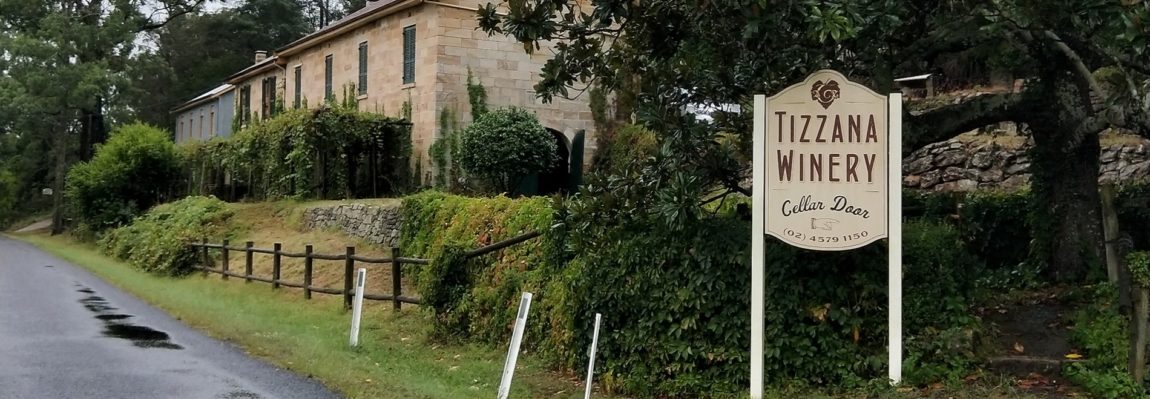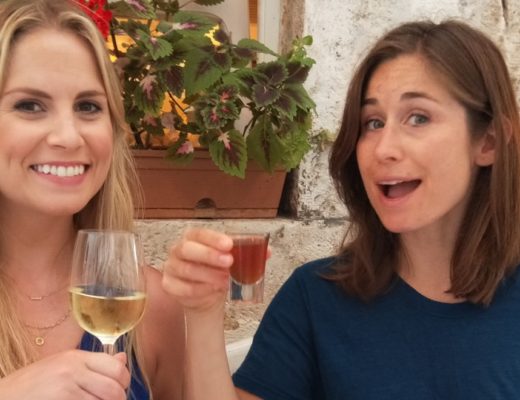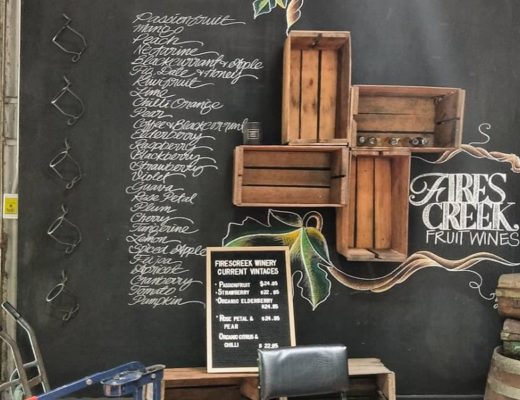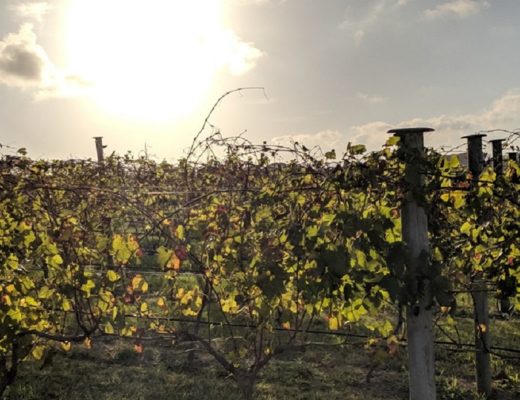About an hour north west of Sydney lies historic Hawkesbury. It’s a stunning area and was the source of food for aboriginal people then emancipist settlers from 1794. The area is known for its beautiful river views and activities, local produce and my favourite part, Hawkesbury River Wineries.
Home to some of Australia’s oldest vineyards in Australia, not many people know about Hawkesbury River Wineries and Sydney’s outer wine trails. The trail skirts Sydney’s west from Hawkesbury down to Camden but for our trip, we stuck to the Hawkesbury area and visited three of the local wineries. Here’s how it went…
Wineries
1. Tizzana Winery
Tizzana is a beautiful old, Italian inspired building dating back to 1887. The land was originally purchased by a famous Italian surgeon, Dr Thomas Fiaschi who developed and established 55 of the 250 acres as vineyards. He named it Tizzana as it reminded him of his home village outside of Florence in Italy and even in the rain I see what he saw back in the day with the rolling hills throughout the valley and the river flowing peacefully nearby.
The area flourished until bushfire swept through the valley in the 1950s, sadly destroying the vines and leaving the building derelict for the next decade. But in the 1960s, current owners Peter and Carolyn Auld discovered the winery site in ruins and took on the task of restoring the building and area to its former glory and opening the vineyard and cellar door to the public.
We step into the cool, stone building and as our eyes adjust, we are greeted by Peter who took to serving us Tizzana’s finest. We started off with their white wine that comes from another vineyard up the river, but it’s quickly made clear that their reds and fortifieds from the local site are where they pride themselves most.
We start with the Shiraz which is light (especially for Australian Shiraz!) and has a peppery taste from the late and short sun they get in the valley. The climate down there is similar to the Hunter, warm to hot, but the valley means shorter sun exposure as it comes up late over the hill and disappears earlier, dropping out of sight on the other side of the river walls. This means that the grapes take a few extra weeks to develop before they’re picked. It also means this sumptuous Shiraz exhibits traits that usually come from cooler climates despite the area actually being warm to hot. The wine intrigued me and I ended up taking one of these bad boys home for later consumption.
Moving on, we tried the Tannat next, a French grape that I’d never tasted before. It had chalky tannins and Peter explained that it’s good for mixing with other grapes to give it the dry finish. An interesting wine but not for me.
Petit Verdot followed and then a blend of both Shiraz and PV before we got in to the fortifieds. All were delicious with different flavours and strengths, the white port in particular was my favourite, but I’m not a big fortified wine drinker unless I’m in Portugal with my parents and they’re leaving the bottle on the table after dinner. Anyone else tackled a bottle before? Just us?
Peter along with his friends, family and helpers had been grape picking that morning (despite the rain) and had a picking party after with breakfast. We were lucky enough to, well, miss the soaking they got during picking, but we did get a look at their hard earned pickings as well as the machinery and grapes fermenting in the vats out the back.
Not only is the wine and small scale production enough to draw you in but the place is kitted out with cool trinkets like the cool till. An amazing building with interesting history and lovely wines made for a successful first stop. Next up we crossed the road to what was once part of Tizzana and is now a winery in it’s own standing.
2. Jubilee Vineyard Estate
Originally part of Dr Fiaschi’s Tizzana grounds, Jubilee vineyard was re-established with vines in 2001 after the bushfires years before. Chambourcin, a French/American hybrid grape variety, was the chosen grape planted and is particularly suited to growing in the hot, humid region due to its resistance to fungal diseases. Chambourcin is another grape I had never tried and it produces a deep, purple style colour in the wine.
The current owner, Ray, welcomed us with open arms and gave us the star treatment that not only included wine (obvs) but also the homemade hummus. Ah-mazing and just what we need for round two of tastings.
Starting us off on the Unlabelled Early Harvest Rosé from 2009, the colour was dark, almost burnt orange and the taste had a hint of cranberry and a long palate. Quite intense! The 2010 rosé had strawberry notes and long finish. Now as Chambourcin is technically a white grape, this deep red coloured wine is technically a white wine. The grapes are naturally this colour so the colour isn’t developed from skins being left on as you’d expect. We tried both the 2010 which was the cooler year and the 2009 version which was the warmer year but the 2010 got the majority vote from the group due to its rich flavour.
Starting us off on the Unlabelled Early Harvest Rosé from 2009, the colour was dark, almost burnt orange and the taste had a hint of cranberry and a long palate. Quite intense! The 2010 rosé had strawberry notes and long finish. Now as Chambourcin is technically a white grape, this deep red coloured wine is technically a white wine. The grapes are naturally this colour so the colour isn’t developed from skins being left on as you’d expect. We tried both the 2010 which was the cooler year and the 2009 version which was the warmer year but the 2010 got the majority vote from the group due to its rich flavour.
Last up was the 2005 rosé. Now this stuff was special, I mean, when in your life have you tasted a 14 year old rosé?! It was clean and fresh, not sweet but fruit forward. These grapes were left on the vines for a bit longer to increase the flavour and results in a wine that tastes almost fortified. A rare wine and brilliant tasting experience.
Suitable squiffy, we squeeze in one last taster, a 2011 sparkling red chambourcin for the road before negotiations begin on purchases and we leave with a box full of wines. So far we’re smashing glasses and goals on our quaint country tour. Last stop, Bull Ridge.
3. Bull Ridge Estate Winery
Now I have to admit, Ray’s generosity at Jubilee got me and we’re all a bit sozzled/on our way by this point, but we pull up at Bull Ridge and are greeted by two lovely dogs, one old and one pup, before the the owner arrives after running errands in town.
He opened up shop for us before talking us through the wine list:
- Verdelho and vermentino whites
- A lovely fruity rosé
- Infamous Shiraz and
- Durif
- Finishing on a blend of Shiraz and Durif wine before concluding the tour on the prized fortifieds.
I really enjoyed the Shiraz Durif blend with its plum, spice flavours and deep tannin from the grapes and French oak used during the wine making process. But after a long day on the wine road, the fortifieds won at this winery and we leave with a couple of bottles to take home.
All in all, a good time was had and the vino did flow. This lesser known region is truly beautiful, the river is quite calming and the wines are good – all this tucked away in the valley just a stone’s throw from Sydney. These Hawkesbury River Wineries are definitely places you should to explore if you’re looking to get off the beaten track and learn a bit more about wine making down under.
What do you think of Hawkesbury River Wineries? Where have you been exploring? Feel free to leave a comment or say hello on the ‘gram.
Cheers, Lorna
Don’t fancy Hawkesbury River Wineries? Try Shoalhaven Coast Wineries NSW.





No Comments